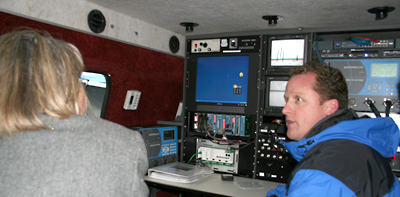
|
CONNECTIONS
|
IDAHO
ITD
HOME
IDAHO DMV
ITD
NEWS
HIGHWAY
SAFETY
IDAHO STATE
POLICE
TRAVEL SERVICES
STATE OF IDAHO
NATIONAL
AASHTO
AAMVA
AAA of IDAHO
FEDERAL HIGHWAYS
FEDERAL AVIATION
IDAHO STATE POLICE
NHTSA
NTSB
TRB
U.S. DOT
Idaho
Transportation
Department
Public Affairs Office
P.O. Box 7129
Boise, ID 83707
208.334.8005
Fax: 208.334.8563
Email


Vehicle
technology demonstration reveals
safety features of the future
Had there been more traffic on the test driving track Thursday, a demonstration of new vehicle technology could have shown collision avoidance capabilities in winter driving conditions. Instead, the demonstration showed how new technology can warn drivers when they enter a highway construction zone and when a traffic signal is about to turn red.
ITD, with cooperation from the state police, brought the Intelligent Transportation System (ITS) America demonstration to Idaho.
 The
Vehicle Infrastructure Integration (VII) Roadshow featured a control
van with a 40-foot hydraulic mast that resembles television satellite
trucks. Several video-detection cameras mounted atop the mast served
as “eyes” for the computer equipment inside the van.
The
Vehicle Infrastructure Integration (VII) Roadshow featured a control
van with a 40-foot hydraulic mast that resembles television satellite
trucks. Several video-detection cameras mounted atop the mast served
as “eyes” for the computer equipment inside the van.
“VII is one approach within the field of intelligent transportation systems that helps improve driver safety and reduces delays due to congestion,” according to ITS America. “Data transmitted between vehicles, and from the roadside to the vehicle, could warn a driver that it is not safe to enter an intersection.
“Vehicles could serve as data collectors and anonymously transmit traffic and road condition information from every major road within the transportation network.”
VII takes roadway safety further by helping to prevent crashes through rear-end collision avoidance systems, intersection collision avoidance systems and road departure collision avoidance systems.
Thursday’s demonstration used radio signals (called Dedicated Short Range Communication) from a Chrysler mini-van to send information to the control center and on to a temporary traffic signal.
A group of about 40 people, including engineering students from four universities in the Northwest, assembled for a 1 p.m. news conference. Afterward, they rode in the mini-van and observed vehicle technology first-hand.
While groups of four or five people took their turns in the demonstration vehicle, others huddled in an open-sided shelter, watching horizontal snow sweep across the ISP track. The blizzard-like conditions added a sense of reality to the demonstration of emerging technology as a safety feature in new automobiles.
 Neil
Schuster, president and chief executive officer for ITS America, said
the new technology could be incorporated into U.S. autos within five
years. The introduction of technologically enhanced cars likely will
depend on the level of commitment by local, state and federal transportation
agencies to build new technology into intersections and highways.
Neil
Schuster, president and chief executive officer for ITS America, said
the new technology could be incorporated into U.S. autos within five
years. The introduction of technologically enhanced cars likely will
depend on the level of commitment by local, state and federal transportation
agencies to build new technology into intersections and highways.
Schuster said a decision at the federal level to upgrade intersections could come as early as next year.
Technicians who demonstrated the equipment said highways have reached critical mass. In many urban areas there isn’t sufficient space to add new traffic lanes to ease congestion. Technology will play a growing role in the safe and efficient movement of traffic.
“As the need for transportation overwhelms our highways and roadways, there is a greater demand to improve safety, reduce traffic congestion, lessen fuel consumption and provide drivers with real-time, life-saving traffic and road condition information,” according to TechnoCom, one of the partners in the ITS America demonstration.
Joining Schuster as speakers at the news conference were ITD’s Greg Laragan and Terry Little, traffic services manager for Ada County Highway District.
Published 3-2-07